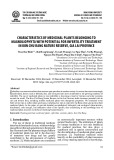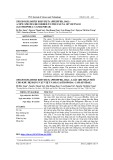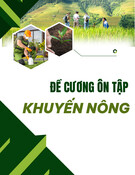
http://www.iaeme.com/IJMET/index.asp 749 editor@iaeme.com
International Journal of Mechanical Engineering and Technology (IJMET)
Volume 10, Issue 03, March 2019, pp. 749–758, Article ID: IJMET_10_03_078
Available online at http://www.iaeme.com/ijmet/issues.asp?JType=IJMET&VType=10&IType=3
ISSN Print: 0976-6340 and ISSN Online: 0976-6359
© IAEME Publication Scopus Indexed
EFFECTS OF FOREIGN TRADE ON
AGRICULTURAL OUTPUT IN NIGERIA
(1981-2018)
NWANJI, Tony Ikechukwu
Department of Accounting and Finance, Landmark University, Omu-Aran, Nigeria
LAWAL, Adedoyin Isola
Department of Accounting and Finance, Landmark University, Omu-Aran, Nigeria
ASAMU, Festus
Department of Sociology, Landmark University, Omu-Aran, Nigeria
INEGBEDION, Henry
Department of Business Studies, Landmark University, Omu-Aran, Nigeria
ABSTRACT
The current study examined the impact of foreign trade on agricultural output in
Nigeria based on data sourced from 1981 to 2018 by employing a number of
estimation techniques such as Cobb-Douglas, unit root testing, autoregressive
distributed lag among others within the context of two profound theories of exchange
rate - the vent – for surplus theory of international trade; factor endowments theory.
Our study observed that foreign trade exerts negatively on agricultural output. Our
results have some empirical implications.
Key words: Foreign trade, agricultural productivity, Nigeria, Unit root test, stationary
Cite this Article: NWANJI, Tony Ikechukwu, LAWAL, Adedoyin Isola, ASAMU,
Festus, INEGBEDION, Henry, Effects of Foreign Trade on Agricultural Output in
Nigeria (1981-2018), International Journal of Mechanical Engineering and
Technology 10(3), 2019, pp. 749–758.
http://www.iaeme.com/IJMET/issues.asp?JType=IJMET&VType=10&IType=3
1. INTRODUCTION
Nigeria has been noted to be a gifted country when it comes to natural resources. Every
country that is industrialized today passed through agrarian era. In fact, agricultural sector still
remains the backbone of the industrial sector. In most developing nations, foreign trade is
very central to all facets of economic growth and development which include agriculture.
Prior to the discovery of oil in 1960's, agriculture was the main source of revenue to the
nation (Lawal, A. I., Asaleye, A.J., IseOlorunkanmi, J. & Popoola, 2018); (Adedoyin Isola

Effects of Foreign Trade on Agricultural Output in Nigeria (1981-2018)
http://www.iaeme.com/IJMET/index.asp 750 editor@iaeme.com
Lawal, Nwanji, Asaleye, & Ahmed, 2016); (Asaleye, A. J., Isoha, L. A., Asamu, F.,
Inegbedion, H., Arisukwu, O., Popoola, 2018); (Ayopo, Isola, & Olukayode, 2016).
Nigeria has been noted to be one of the countries who depend on importation, preference
for foreign products, with a huge neglect on locally produced product. The Nigerian
agricultural sector has experience low production output due to self-inflicted factor of massive
importation of food items to feed the ever increasing population. The nation does not create
enough food to meet the demand of its citizens. This delivers a great deal of issues with
respect to agricultural advancement. By and large, there is less motivation for neighborhood
ranchers to develop, when less expensive, more attractive foods are transported in (Lawal,
A.I., Nwanji, T.I., Adama, I.J., Otekunrin, 2017); (Asaleye, A. J., Popoola, O., Lawal, A. I.,
Ogundipe, A. & Ezenwoke, 2018). There is requirement for consideration regarding be paid
on Agricultural output. This paper examined the effect of foreign trade on agricultural output
in Nigeria with a focus on the export channel.
OBJECTIVE OF THE STUDY
The main objective of the study is to examine the effect of foreign trade on the growth of
agricultural output in Nigeria; hence specific objectives are as follows:
- To examine the relationship that exists between agricultural exports and agricultural output.
- To examine if there is a relationship between exchange rate and agricultural output.
- To examine if there is a relationship between custom duties on imported agricultural
equipment and agricultural output.
2. THEORETICAL FRAMEWORK
Two theoretical notes governs this work, they are briefly discussed as follows:
2.1. Factor Endowments Theory
David Ricardo Theory contended that the premise of global exchange is the relative favorable
position in creation cost. His model does not give a response to the inquiry why nations have
near preferred standpoint and similar disservice in the generation of different products.
Ricardo display does not build up why there are contrasts underway plausibility bend of two
nations. The Heckcher-Ohlin model of exchange expresses that relative favorable position in
the cost of creation is clarified only by the distinctions in the factor enrichment of the Nations.
Factor blessing, for example, accessibility of assets incorporates endowment of nature and
also man-made methods for creation. He contended that the factor enrichments of nations are
unique; there are countries that have wealth of capital while others have plenitude of work.
Accordingly, a work serious country has near cost advantage in the creation of merchandise
that are work serious, while capital bottomless nations have near cost advantage in the
generation of merchandise that require capital-serious innovation. One ramifications of this
casing work is that exchange builds the genuine come back to the factor that is moderately
copious in every nation and brings down the genuine come back to the next factors (Lawal, A.
I., Somoye, R.O.C., Babajide A. A. and Nwanji, 2018); (Lu, Li, Zhou, & Qian, 2017);
(Skorepa & Komarek, 2015).
2.2. The Vent – For Surplus Theory of International Trade
The hypothesis of vent-for-surplus was created by Adam Smith (1937) to broadening
household advertise. It was extended with regards to creating countries. This hypothesis
accepted positive relationship between universal exchange and financial development. As per
this hypothesis, the opening of world markets to remote agrarian social orders makes

NWANJI, Tony Ikechukwu, LAWAL, Adedoyin Isola, ASAMU, Festus, INEGBEDION, Henry
http://www.iaeme.com/IJMET/index.asp 751 editor@iaeme.com
openings not to migrate completely utilized assets as in the customary models yet rather to
make utilization of in the past underemployed land and work assets to deliver more
noteworthy yield for fare to remote markets. Additionally, the sit out of gear assets would be
enough used with advancement of exchange and it will expand the generation of essential
items for trade in this manner moving the household economy towards its generation
plausibility wilderness (Nakatani, 2018); (Thorbecke, 2018).
2.3. Empirical Framework
(Erten & Metzger, 2019) employed a comprehensive cross-country dataset from 1960 to 2015
for a set of 103 developed and developing economies so as to know whether or not exchange
rate manipulation induces changes in labour market. The study observed that developing
economies with an undervalued real exchange rate experiences increase in female labour
force participants.
(Guzman, Antonio, & Stiglitz, 2018) examined the impact of exchange rate policies on
economic development and observed that a stable and competitive exchange rate policy can
positively impact on any observed externality and any market distortions, which will in turn
induce positive economic growth. The authors further observed that conventional industrial
policies that enhances the elasticity of the aggregate supply to the exchange rate ((Y. Chen &
Ward, 2019); (Kim & Hyun, 2018); (He, Zhu, Chen, & Shi, 2015); (Parsley & Popper, 2014);
(Adedoyin Isola Lawal, Babajide, Nwanji, & Eluyela, 2018); (Adedoyin Isola Lawal et al.,
2019); (Ayopo, B. A., Isola, L. A. & Olukayode, 2016); (Ayopo, B. A., Isola, L. A. &
Olukayode, 2016); (Ayopo, Isola, & Olukayode, 2015)).
(Bouvet, Ma, & Assche, 2017) assessed the impact of firm’s import content on the degree
of tariff and exchange rate pass-through into export prices for the Chinese economy. The
study employed pricing-to-market model as well as firm-level data for the period 2000 to
2006, and observed that a firm’s import content share significantly impact negatively on the
depth of exchange rate pass-through but does not affect the level of tariff pass-through (Isola,
L. A., Frank, A. and Leke, 2015); (Fashina, Asaleye, Ogunjobi, & Lawal, 2018); (Lawal, A.
I., Oye, O. O., Toro J. & Fashina, 2018); (Smallwood, 2019); (Alley, 2018)..
(P. Chen, Zeng, & Lee, 2018) assessed the effect of currency under- and overvaluation on
China’s export and the spillover effects of these misalignments toward the exports of 9 Asian
main markets. The study traced the core force for global trade imbalance to deviation from the
long run equilibrium value as against prior believes that it was induced by exchange rate
fluctuations. The study further identified both bilateral and weighted average real exchange
rates as driven factors of Renminbi (RMB) misalignments (Rodriguez, 2016).
For the Iranian economy, (Khalighi & Fadaei, 2017) examined the impact of exchange
rate on export as a key factor in foreign currency income emanating from agricultural
produce, based on data sourced from 1991 to 2001. The study employed simple ordinary least
square and stationary tests. The study observed that exchange rate is key crucial factor for
dates export and also for exporters. The study further observed that exchange rate unification
without appropriate exchange rate policy regime will induce a negative effect on the economy
(Demian & Mauro, 2018); (Bouraoui & Phisuthtiwatcharavong, 2015); (OO Oye, AI Lawal,
AA Eneogu, 2018); (Lawal, A. I., Nwanji, T. I., Oye O. O., Adama, 2018); (A. I. Lawal,
2014).
For the Argentinean economy, (N. Chen & Juvenal, 2016) employed both theoretical and
empirical models to examine the impact of real exchange rate changes on behavior firms’
exporting multiple products with heterogeneous level of quality. The model was characterized
with a demand elasticity that decreases with quality; forecast more pricing – to – market and a
smaller response of export volumes to a real depreciation for higher quality goods. The study

Effects of Foreign Trade on Agricultural Output in Nigeria (1981-2018)
http://www.iaeme.com/IJMET/index.asp 752 editor@iaeme.com
noted existence of robust heterogeneity of response of export prices and volumes to changes
in the exchanges rate regime (Spengler, Miller, Neef, Tourtellotte, & Chang, 2017); (Lawal,
A. I., Awonusi, F. and Oloye, 2015)
3. MATERIALS & METHODS
Base on the nature of the objective of this study, secondary data will be employed.
Secondary data: can be referred to as any information that was gathered by other researchers
or investigators. For example, census data, financial records and statistics are considered
secondary data The data will be collected from the annual CBN statistical bulletin, National
bureau statistics (NBS), and Federal Ministry of Agriculture (FMA).
3.1. Model Specification
Using of Cobb-Douglas growth theory, a mathematical form of our model would be built on a
single equation model which would involve specifying a multiple regression equation to
check the economic relationship between agricultural output as the dependent variable, with
Value of Agricultural Output (VAO) as a proxy, and the independent variables which
comprises of (AE, ACGSF, RER, IDI), government expenditure on agriculture as well as
Labor and capital which will also be independent variables because Cobb-Douglas theory is a
production theory. The model is therefore specified in a production function form as:
VAO= f (AEX, ACGSF, RER, IDI, GEA, LAB, GFC)
Econometrically, the above equation 1, becomes
AGDP = a0 + a1AEX + a2ACGSF + a3RER + a4IDI + a5GEA + a6LAB + a7GFC + μ……..
(2)
VAO= Agricultural Output
AEX= Agricultural Export
ACGSF= money supply (physical money)
RER= broad money (savings deposits, money market mutual funds and other time
deposits).
IDI= Real Interest Rate
LAB= Labor (Employment)
GFC= Capital (GFCF)
GEA= Government Expenditure on Agriculture
RER= Real Exchange Rate
a0, a1, a2, a3, a4, a5, a6 = Parameters
μ= Error term.
4. METHOD OF DATA ANALYSIS
The study adopts econometric method of analysis to evaluate the effect of foreign trade on
agricultural output making use of Auto-Regressive Distributed Lag (ARDL) model. However,
for the estimation of the model, the variables must be stationary at level or first difference,
hence, Unit Root Test for stationarity specifically, the Augmented Dickey-Fuller (ADF) test
would be carried out.
4.1. Unit Root Test
The Augmented Dickey-Fuller test was conducted for the variables to test for stationarity and
non-stationarity of the data used.

NWANJI, Tony Ikechukwu, LAWAL, Adedoyin Isola, ASAMU, Festus, INEGBEDION, Henry
http://www.iaeme.com/IJMET/index.asp 753 editor@iaeme.com
T-stat
Probability
Significance level
Integration order
AGDP
-3.604426
0.0008
1st Difference
I(1)
AEX
-3.555213
0.0123
At level
I(0)
ACGSF
-6.559533
0.0000
1st Difference
I(1)
IDI
-5.406382
0.0001
At level
I(0)
EXR
-3.644683
0.0099
1st Difference
I(1)
GEA
-6.983048
0.0000
1st Difference
I(1)
LAB
-6.373825
0.0000
1st Difference
I(1)
GFCF
-3.689676
0.0092
At level
I(1)
Source: Author’s computation with EViews 10
The table above presents the summary of unit root tests results gotten at levels and first
difference. The decision rule for the ADF Unit root test states that the ADF Test statistic value
must be greater than the Mackinnon Critical Value at 5% absolute term for stationarity to be
established at level and if otherwise, differencing occurs using the same decision rule.
4.2. ARDL Cointegration
The unit root test above shows a combination of 1(0) and 1(1) therefore, ARDL is a most
suitable technique of estimation to be used.
VARIABLES
COEFFICIENT
STANDARD
ERROR
T-STAT
PROBABILITY
AEX
-0.208852
0.172811
-1.208558
0.2501
ACGSF
-0.024556
0.256397
-0.095772
0.9253
EXR
0.042386
0.012483
3.395365
0.0053
IDI
-0.160911
0.070502
-2.282363
0.0415
GEA
-0.029355
0.033150
-0.885519
0.3933
LAB
-1.051787
0.357803
-2.939571
0.0244
GFCF
0.046348
0.059296
0.781632
0.4496
C
0.360152
1.931846
0.186429
0.8552
Source: Author’s computation Eviews 10
R-SQUARED= 0.998645 Adjusted R-squared=0.996272
R-SQUARED= 0.998645 this shows that the independent variables jointly explain about
99.8% variation in the dependent variable. The Adjusted = 0.996272 and it takes into
cognizance the degree of freedom. The Adjusted is usually less than the and it shows
that after removing the unwanted variables, the independent variables explain about 99.6
percent of the dependent variable.
Source: Author’s computation Eviews 10
.60
.62
.64
.66
.68
.70
.72
ARDL(2, 1, 2, 2, 2, 2, 2, 1)
ARDL(2, 1, 2, 2, 2, 2, 2, 2)
ARDL(2, 2, 2, 2, 2, 2, 2, 1)
ARDL(2, 2, 1, 2, 2, 2, 2, 1)
ARDL(1, 2, 0, 2, 2, 2, 2, 1)
ARDL(2, 1, 1, 2, 2, 2, 2, 1)
ARDL(2, 1, 0, 2, 2, 2, 2, 1)
ARDL(1, 2, 0, 2, 2, 0, 2, 2)
ARDL(1, 2, 0, 2, 2, 0, 2, 1)
ARDL(2, 2, 0, 2, 2, 2, 2, 1)
ARDL(1, 2, 0, 2, 2, 2, 2, 2)
ARDL(2, 2, 2, 2, 2, 2, 2, 2)
ARDL(2, 0, 0, 2, 2, 2, 2, 1)
ARDL(1, 1, 0, 2, 2, 2, 2, 1)
ARDL(1, 2, 1, 2, 2, 0, 2, 1)
ARDL(1, 2, 1, 2, 2, 2, 2, 1)
ARDL(1, 0, 0, 2, 2, 0, 2, 1)
ARDL(2, 2, 1, 2, 2, 2, 2, 2)
ARDL(1, 1, 2, 2, 2, 2, 2, 1)
ARDL(1, 2, 1, 2, 2, 0, 2, 2)
Akaike Information Criteria (top 20 models)














![Bài tập Nông nghiệp đại cương [nếu có thêm thông tin về loại bài tập, ví dụ: trắc nghiệm, thực hành,... thì bổ sung vào]](https://cdn.tailieu.vn/images/document/thumbnail/2025/20251124/stu755111075@hnue.edu.vn/135x160/57241763966846.jpg)







![Hướng dẫn thực hiện khóa đào tạo nghề Kinh doanh nông nghiệp [chuẩn nhất]](https://cdn.tailieu.vn/images/document/thumbnail/2025/20251114/kimphuong1001/135x160/9931763094163.jpg)
![Biến đổi khí hậu và ảnh hưởng tới nông nghiệp: Tài liệu [mới nhất/quan trọng/chi tiết]](https://cdn.tailieu.vn/images/document/thumbnail/2025/20251107/kimphuong1001/135x160/23061762507164.jpg)


